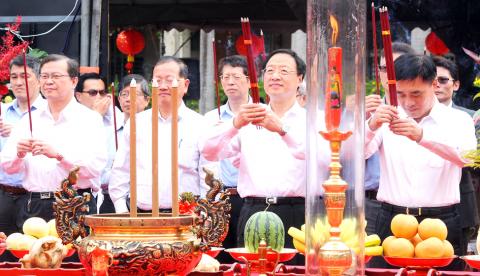Construction for Taipei’s new Wanda (萬大) MRT line is to take four times longer than other MRT lines, Taipei’s Department of Rapid Transit Systems (DORTS) said yesterday.
The department said it estimated that the Wanda line would take eight years to construct, compared with two years for a typical MRT line.
Plans approved by the Executive Yuan envision a line running through Taipei’s Wanhua District (萬華) and looping through several districts of New Taipei City to link with the Huilong (迴龍) terminal station of the Zhonghe-Xinzhuang-Luzhou Orange Line.

Photo: Liu Hsin-de, Taipei Times
A second ground-breaking ceremony for the line was held in Taipei yesterday, following a ceremony in New Taipei City last month.
Premier Jiang Yi-huah (江宜樺) said at the event that the Wanda line’s aim was different from previous lines, which focused on providing more convenient transportation to business districts.
“The Wanda line will run deeply into less developed districts,” Jiang said.
“The fact that it will bring economic development to the area around each station is even more important than its ability to provide a clean and efficient form of transportation,” he said.
Despite the project’s importance, it has been plagued with difficulties since its inception more than nine years ago, Taipei Mayor Hau Lung-bin (郝龍斌) said, adding that the dense population along the line’s route creates numerous engineering challenges.
The department said that the narrow roads under which the line would be constructed drastically reduce the availability of above-ground construction space, forcing the department to use painstaking tunneling methods for most of the line’s length.
Besides creating engineering difficulties, the narrow roads would also strictly limit the line’s size, with its final capacity significantly lower than most of Taipei’s current MRT lines, it added.
The line would feature the smallest station in the city’s MRT system, to avoid unnecessary impact on an important archaeological site near the Taipei Botanical Garden, the department said, adding that completing archaeological excavations during construction would further slow the line’s progress.
Liu Yi-chang (劉益昌), a professor of history and philology at Academia Sinica, said the ancient Aboriginal village through which the line would pass is one of the most significant archeological sites in Taipei.
Due to the village’s 4,000 years of history, different layers of cultural artifacts are found as deep as 6m, he said.

Taiwan is to commence mass production of the Tien Kung (天弓, “Sky Bow”) III, IV and V missiles by the second quarter of this year if the legislature approves the government’s NT$1.25 trillion (US$39.78 billion) special defense budget, an official said yesterday. Commenting on condition of anonymity, a defense official with knowledge of the matter said that the advanced systems are expected to provide crucial capabilities against ballistic and cruise missiles for the proposed “T-Dome,” an advanced, multi-layered air defense network. The Tien Kung III is an air defense missile with a maximum interception altitude of 35km. The Tien Kung IV and V

The disruption of 941 flights in and out of Taiwan due to China’s large-scale military exercises was no accident, but rather the result of a “quasi-blockade” used to simulate creating the air and sea routes needed for an amphibious landing, a military expert said. The disruptions occurred on Tuesday and lasted about 10 hours as China conducted live-fire drills in the Taiwan Strait. The Civil Aviation Administration (CAA) said the exercises affected 857 international flights and 84 domestic flights, affecting more than 100,000 travelers. Su Tzu-yun (蘇紫雲), a research fellow at the government-sponsored Institute for National Defense and Security Research, said the air

Taiwan lacks effective and cost-efficient armaments to intercept rockets, making the planned “T-Dome” interception system necessary, two experts said on Tuesday. The concerns were raised after China’s military fired two waves of rockets during live-fire drills around Taiwan on Tuesday, part of two-day exercises code-named “Justice Mission 2025.” The first wave involved 17 rockets launched at 9am from Pingtan in China’s Fujian Province, according to Lieutenant General Hsieh Jih-sheng (謝日升) of the Office of the Deputy Chief of the General Staff for Intelligence at the Ministry of National Defense. Those rockets landed 70 nautical miles (129.6km) northeast of Keelung without flying over Taiwan,

City buses in Taipei and New Taipei City, as well as the Taipei MRT, would on Saturday begin accepting QR code payments from five electronic payment providers, the Taipei Department of Transportation said yesterday. The new option would allow passengers to use the “transportation QR code” feature from EasyWallet, iPass Money, iCash Pay, Jkopay or PXPay Plus. Passengers should open their preferred electronic payment app, select the “transportation code” — not the regular payment code — unlock it, and scan the code at ticket readers or gates, General Planning Division Director-General Liu Kuo-chu (劉國著) said. People should move through the